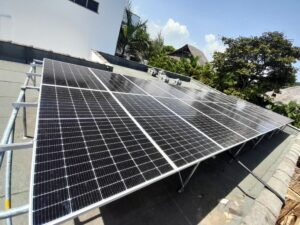How to Size a Solar Power System

Transitioning to solar energy is a commendable step toward sustainability and energy independence. To ensure optimal performance and cost-effectiveness, it’s important to consider sizing your solar energy system accurately. This comprehensive guide will walk you through the critical steps involved in determining the appropriate system size tailored to your energy needs.
1. Assessing Your Energy Consumption
Begin by conducting a thorough evaluation of your household or business’s energy usage. This involves:
- Reviewing Electricity Bills: Analyse your utility bills over the past year to determine your average monthly and daily energy consumption, measured in kilowatt-hours (kWh). This data provides a baseline for your energy requirements.
- Identifying Peak Usage Periods: Recognise times of the day or year when energy consumption spikes. This insight is crucial for designing a system that can handle peak loads efficiently.
2. Evaluating Solar Potential
Understanding your location’s solar potential is vital for system sizing:
- Sunlight Availability: Determine the average number of peak sun hours your location receives daily. A peak sun hour equates to an hour of sunlight intensity at 1,000 watts per square meter. This metric varies based on geographical location and seasonal changes.
- Site Assessment: Examine your property for factors that could influence solar panel performance, such as roof orientation, tilt angle, and potential shading from nearby structures or vegetation.
3. Calculating the Required System Size
With your energy consumption and solar potential data in hand, proceed to calculate the necessary system size:
- Daily Energy Requirement: Confirm your household’s daily energy consumption in kWh.
- System Capacity Calculation: Divide your daily energy requirement by the average daily peak sun hours to determine the required system capacity in kilowatts (kW).
System Size (kW)=Daily Energy Consumption (kWh)/Average Daily Peak Sun Hours
- Accounting for System Losses: Solar power systems experience efficiency losses due to factors like inverter inefficiency, wiring, and environmental conditions. It’s prudent to include a margin of 20-25% to accommodate these losses.
Adjusted System Size (kW)=System Size (kW)×1.25
4. Selecting Appropriate Solar Panels
Choose solar panels that align with your calculated system size:
- Panel Efficiency: Panels vary in efficiency, typically ranging from 15% to 22%. Higher efficiency panels generate more electricity per square meter but may come at a higher cost.
- Number of Panels: Determine the number of panels required by dividing the total system capacity by the wattage of the selected panels.
Number of Panels=Adjusted System Size (kW)×1,000/Panel Wattage (W)
5. Inverter Sizing
The inverter is a critical component that converts the direct current (DC) produced by solar panels into alternating current (AC) used by most appliances:
- Inverter Capacity: Ensure the inverter’s capacity matches or exceeds the total wattage of your solar array. It’s advisable to select an inverter with a capacity 25-30% higher than your system’s peak output to handle potential surges and maintain longevity.
Read More: How to Calculate the Size of an Inverter for Your Solar Power System
6. Battery Storage Considerations
If you plan to incorporate battery storage for energy use during non-sunlight hours or emergencies:
- Battery Capacity: Calculate the required battery capacity based on your energy consumption patterns and desired autonomy period (the number of days you wish to sustain your energy needs without solar input).
Battery Capacity (Ah)=Daily Energy Consumption (Wh)×Days of Autonomy/ System Voltage (V)×Depth of Discharge×Battery Efficiency
- Depth of Discharge (DoD): Most batteries have a recommended DoD, typically around 50-80%, indicating the proportion of the battery’s capacity that can be used without significantly affecting its lifespan.
- Battery Efficiency: Account for energy losses during charging and discharging, usually around 85-95%.
7. Consulting with Solar Professionals
While this guide provides a foundational understanding, it’s essential to collaborate with experienced solar professionals who can:
- Conduct Detailed Site Assessments: Professionals can perform shading analyses, structural evaluations, and other critical assessments to ensure optimal system design.
- Navigate Regulatory Requirements: They can assist with permits, grid interconnection agreements, and compliance with local regulations.
- Provide Maintenance and Support: Ongoing maintenance is crucial for system longevity and performance. Professionals offer services to monitor and maintain your system effectively.
Sizing a solar energy system might seem daunting, but by breaking it down into these steps, it’s entirely manageable. Assess your energy needs, understand your local solar potential, and choose components that fit your requirements. And don’t hesitate to consult with professionals to ensure your system is safe, efficient, and optimised for your situation.

2 Comments
JM
August 18, 2024Joseph Kimani
June 19, 2025